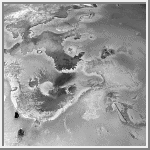|
COMETS EARTH JUPITER KUIPER BELT MARS MERCURY METEORITES NEPTUNE OORT CLOUD PLUTO SATURN SOLAR SYSTEM SPACE SUN URANUS VENUS ORDER PRINTS
PHOTO CATEGORIES SCIENCEVIEWS AMERICAN INDIAN AMPHIBIANS BIRDS BUGS FINE ART FOSSILS THE ISLANDS HISTORICAL PHOTOS MAMMALS OTHER PARKS PLANTS RELIGIOUS REPTILES SCIENCEVIEWS PRINTS
|
Related Document
Download Options
Shown here is a portion of one of the highest- resolution images of Io (Latitude: +10 to +60 degrees, Longitude: 180 to 225 degrees) acquired by the Galileo spacecraft, revealing immense lava flows and other volcanic landforms. Several high-temperature volcanic hot spots have been detected in this region by both the Near Infrared Mapping Spectrometer and the imaging system of Galileo. The temperatures are consistent with active silicate volcanism in lava flows or lava lakes (which reside inside irregular depressions called calderas). The large dark lava flow in the upper left region of the image is more than 400 km long, similar to ancient flood basalts on Earth and mare lavas on the Moon. North is to the top of the picture and the sun illuminates the surface from the left. The image covers an area 1230 kilometers wide and the smallest features that can be discerned are 2.5 kilometers in size. This image was taken on November 6th, 1996, at a range of 245,719 kilometers by the Solid State Imaging (CCD) system on the Galileo Spacecraft. Launched in October 1989, Galileo entered orbit around Jupiter on December 7, 1995. The spacecraft's mission is to conduct detailed studies of the giant planet, its largest moons and the Jovian magnetic environment. The Jet Propulsion Laboratory, Pasadena, CA manages the mission for NASA's Office of Space Science, Washington, DC. |
